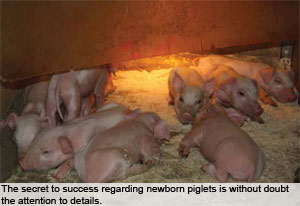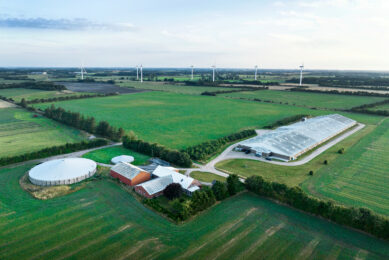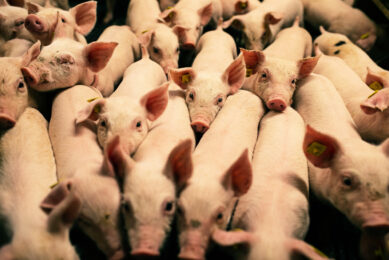Critical steps in addressing pre-weaning mortality

With the top pig producing countries aiming for 35 piglets per sow per year, a remarkable paradox turns up. The more piglets in a litter, the smaller they are – but to keep pre-weaning mortality low, large and healthy piglets are key. How to manage and get the best of both worlds?
By Dr Ioannis Mavromichalis, Ariston Nutrition, Madrid, Spain
There is shortage of piglets throughout Europe. Piglet prices at weaning and 20 kg bodyweight continue to rise and the forecast is they will continue to do so for some time. There is a number of good reasons why this is happening. First, a chronic problem of oversupply, with associated low prices for pork, in the past decade has been recently addressed with a drastic reduction in the sow herd. Second, the global financial crisis restricted capital liquidity for many small- and medium-size producers resulting in many going out of business or downsizing in a market they were losing money fast. Third, environmental regulations are getting tougher by the day making expanding hard even where pig production remains profitable. Thus, it is apparent piglets have become a valuable commodity once again.
With an increasing value on piglets, reducing pre-weaning mortality becomes of paramount importance. Here, the major issue is saving small piglets, which are the ones usually making the largest percentage in pre-weaning mortality. Unfortunately, the number of small piglets per litter has been rising lately. With emphasis on increasing litter size, as a result of genetic improvement, piglet weight at birth has been reduced. In Denmark, for example, with the next target being 35 piglets per sow per year, one may only expect a good number of these to be small piglets, quite often of questionable viability. The problem, therefore, is quite complicated. Not only piglet pre-weaning mortality should be reduced, but efforts should focus on piglets of increasingly lower bodyweight at birth. This makes it even harder to reduce piglet mortality, as small size piglets are even more susceptible to early mortality. From Table 1, it is evident that piglet pre-weaning mortality practically doubles for every 200 g decrease in birth weight from 1,200 down to 600 g.
Financial assessment
The first step before implementing any new intervention strategy should always be to run a projected cost versus profit analysis. For example, in a herd with an already low pre-weaning mortality, it will be very difficult (costly) to reduce it even further, and any projected savings will be eroded fast by expenditure. In other cases, where pre-weaning mortality is running high it might not be feasible at all to invest in reducing it due to lack of available funds. In general, a pre-weaning mortality below 5% is quite difficult to be lowered to a substantial (profitable) degree. In contrast, above 10% is always an easy target, whereas pre-weaning mortality reaching or exceeding 20% should be addressed urgently as it indicates considerable problems.
Training
Having established that reducing pre-weaning mortality is a financially beneficial investment, the next step is to identify the appropriate staff to work on this project. The right person for the right job has never been a cliché better used than in this place! It certainly takes a person with a personal approach to dealing with sick and small-sized piglets. In addition, training should come from an experienced source to avoid delays from learning-on-the-job and ensuring things run smoothly from the very beginning.
Most experts agree in having a single person, or a dedicated small group in larger operations, handling the issue of reducing pre-weaning mortality. Such person would be responsible for identifying piglets with a low potential for survival and arrange their differential treatment. This may often disrupt normal procedures but having established this is a financially desirable operation, all farm personnel should be instructed in helping with.
Specialists
In conjunction with training, specialists must be invited to review normal operating procedures and suggest ways to reduce pre-weaning mortality.
A veterinarian, with a fresh look at the farm, should be the first to suggest new ways to improve the health status. This means not only medications, but improving certain management routines to raise the hygiene level of the whole farm.
A facilities specialist can be of great help identifying flaws in equipment or the way facilities are managed. In certain cases, mortality in newborn piglets is as easy to resolve as fixing or adjusting the farrowing crates. In other cases, expensive measures may be required to ensure a better environment at the piglet level or even at the whole farrowing room level.
A qualified nutritionist must also enter the picture to ensure that small piglets receive appropriate nutrition from birth until weaning.
Critical steps
A number of critical steps in addressing pre-weaning mortality are briefly described below:
I. Identifying piglets at risk
Not all piglets require special treatment to reduce pre-weaning mortality. It is usually those at the lower end of body weight that are at risk to die early after birth. The exact cutoff weight should be established taking a number of parameters into account, most of which are farm-sensitive, but in general piglets below 800 g at birth should be targeted for intervention as these are more likely to suffer from high mortality. At some farms, this may be reduced to 600 g, or increased to 1,000 g, depending on actual average birthweight. Here the idea should be that piglets killed because of very low weight will never have a chance to be weaned, so the less killed the more that can be saved.
II. Timing of intervention
The majority of pre-weaning mortality happens within the first two days after birth when piglets are usually too weak to move around and suckle with vigour. As such, the major cause of early deaths is usually being crushed by the sow as she lies down to rest, with victims being those small and weak piglets without the energy to get out of the way fast. In addition, sick piglets (and here, it is mainly intestinal diseases that cause most damage) are also prone to be crushed as they are naturally less active and they tend to suckle with less vigor. Moreover, the design of the farrowing crate is important in minimising the risk of crushed piglets, as is the supply of an external source of nutrients to small piglets.
III. Cross-fostering
Most would agree that cross-fostering, especially if it is completed within 24 hours after birth is the most successful method in dealing with supernumerary piglets. The opinions are divided however when it comes to which piglets should be transferred away from their natural mother. Some prefer to remove the weak piglets, grouping them all together under a small number of foster mothers, well-known for their better mothering abilities. Others, prefer to leave the smaller piglets with their natural mothers, ensuring the bond is not broken (especially if cross-fostering cannot be completed fast enough). Instead, they remove the largest piglets to supplement smaller litters. The second option eliminates the need of having special foster sows, but implies the natural mothers will take good care of their own (remaining) litter. As such, both systems come with advantages and disadvantages and it is up to each farm to select the system they find works best for their situation.
| Financial results The financial results will depend, of course, on the specifics of each farm. For the benefit of this discussion, however, let us assume a farm with 1,000 breeding sows, with an average 25 pigs born alive. With a typical 10% pre-weaning mortality, this gives us 22.5 piglets weaned per sow per year. Now, after having established a rigorous programme of saving small piglets, let us assume an average drop to pre-weaning mortality from 10.9% (a very possible target). This translates to an increase of 0.25 piglets per sow per year, or 250 pigs per year in total. These 250 pigs, could easily bring €5,000 extra, if we assume a fair price of €20 per head for weaned piglets. Another way to look at this is an extra €5 per sow for reducing mortality by 1% point. From this, one would have to subtract the cost of reducing mortality by 1% point, but it becomes quite obvious there is money to be made (or saved) by saving small piglets. |
IV. Artificial rearing
Cross-fostering assumes there are certain number of sows with small litters, which enables them to become foster mothers. In cases such as in Denmark where litter size is pushed beyond limits, it may not be possible to have even a single foster sow within a farrowing group. Here, artificial rearing is the only alternative option, and it is indeed a technique gaining acceptance worldwide. For this, a set of new facilities is required. In most cases this implies specially designed pens to ensure a warm environment and a system of nutrition that is easy to manage and for the piglets to identify as a source of nourishment. Again, the cost of such system should be included in the financial assessment step described above, as should be the cost of nutrition.
V. Supplements
Having established that piglet mortality is highest during the first two days after birth and that the majority of deaths occurs among the smallest piglets in a litter, it is beneficial to target these piglets immediately after birth to receive a supplement. Such supplements are usually provided in the form of a paste or a semi-liquid, given orally during the first 24 hours after birth. This supplement includes one or more of the following ingredients: a source of energy, usually simple sugars such as dextrose and several lipids, all of which should be highly digestible; a good source of immunoglobulins, specifically designed for piglets, produced from eggs of hens that have been hyper-immunised against piglet-specific diseases (See Figure 1); vitamins and minerals; a probiotic.
Experience has shown this intervention strategy is of singular importance in improving the chances of saving small piglets. Care should be taken, however, the supplement should be swallowed and for that, training is required.
VI. Liquid milk
Provision of a liquid milk diet is necessary in the case of artificial rearing and optional in the case of cross-fostering. In the first case, all piglets are fed a liquid diet for the first two weeks after birth, whereas in the second case, only the weak piglets are targeted to receive the liquid milk diet. The feeding of liquid milk can be done manually in small operations or through an automatic system in larger ones. In both case, hygiene of the feeding system is the key to success. Finally, a high quality milk-based powder is always a further guarantee of enhancing the chances of survival for small piglets. Liquid milk is an excellent vehicle for administering immunoglobulins, probiotics, and other health supplements.
VII. Solid feed
Solid feed, in the form of a complete diet in meal or pellet, should be offered as soon as possible, even from the first week of life. Likewise, piglets should be encouraged to consume dry feed as soon as possible to reduce the expense of feeding liquid milk. Again, a high quality ‘creep’ feed, supplemented with high levels of certain health-enhancing ingredients is the key to success but it’s provision requires special management.
VIII. Feed management
Placing solid feed in containers set in pens or farrowing crates is rarely successful in enticing young pigs to consume dry feed. To ensure a rapid acceptance of solid feed as nourishment, feeding management is important. To this end, feeding a gruel can offer significant advantages. Likewise, feeding on floor-mats usually attracts the curiosity of piglets and enhances the chances of developing an early appetite for dry feed. Finally, the old advise of feeding small quantities at frequent intervals cannot be better suited than in this case.
Saving small piglets that could otherwise be lost towards high figures of pre-weaning mortality is a challenge producers face today with increasing expertise. The secret to success is without doubt the attention to details required for such a delicate operation. To this end, all human and material resources available to producers should collaborate towards a common goal that will ultimately enhance profitability.











